This article was produced in partnership with the Pulitzer Center’s Rainforest Investigations Network.
NORTH KALIMANTAN, Indonesia — Jonni Spedika stared at the neat rows of trees and clenched his jaw. To an outsider, it may look like a serene patch of forest. To Spedika and his fellow villagers, it represents a grave threat.
“This shouldn’t be allowed,” said Spedika, the former chief of one of the main villages here.
Borneo ironwood and other tropical hardwood trees have long blanketed this rugged island in Indonesia. Large numbers of wild pigs, a main food source for the local people, roamed the rainforest near their homes. The trees stood undisturbed, nourishing the soil below and consuming large amounts of the carbon dioxide that fuels climate change.

But the trees irking Spedika on that day in October were not old ironwoods or tallow nuts. They were eucalyptus trees recently planted by the wood supply company, PT. Adindo Hutani Lestari, and they represent the decline of one of the world’s most important rainforest systems, experts say.
Adindo and its competitors have long operated in the region. For years, they cut down large swaths of ancient trees to make way for tree plantations. The wood is transported to mills, where it is dissolved into pulp and spun into a breathable fabric that has become ubiquitous across the U.S.: viscose rayon.
Viscose rayon is used in clothing ranging from couture dresses to t-shirts to sportswear. It has been touted as eco-friendly because it comes from a renewable resource: trees.
But it is also among the products that have driven the destruction of rainforest in Indonesia. The plantations built on the cleared land create a continuous supply of new wood or goods like palm oil, often from a single species of tree.
The plantations blend into the surrounding forest. But experts say they also dry out the land and increase the risk of fires as well as destroy the natural habitat of a diverse array of plants and animals.
“This is like them stealing our seas,” said Spedika, who noted that the pigs and other animals he used to hunt had disappeared.
Ruth DeFries, professor of ecology and sustainable development at Columbia University in New York, said tree plantations are highly disruptive to areas of biodiverse rainforest.
“A plantation of a single kind of tree is a very, very different ecosystem than rainforest with millions of species,” said DeFries, who has done research in Indonesia.
“One of the most beautiful times I had there was shadowing someone who was doing research on orangutans,” she added. “Seeing that their habitat is being destroyed — it’s just heartbreaking.”
Deforestation in a place like Indonesia also has broader impacts. An acre of tree farm doesn’t absorb nearly as much carbon dioxide as an acre of rainforest.
A study published in the journal Nature Communications in 2018 found that each hectare of rainforest converted to palm oil plantations in Indonesia results in 174 lost tons of carbon, and most of it ends up in the air as carbon dioxide.
“Converting rainforest into tree plantations is not a one-to-one tradeoff,” said Gillian Galford, a climate scientist at the University of Vermont who was not involved in the study. “Deforestation like we’ve seen in southeast Asia is one of the number one contributors to climate change.”
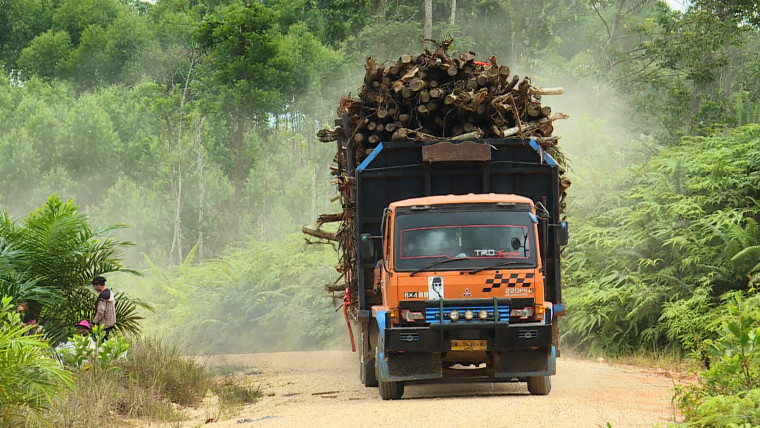
A range of industries have fueled the carving up of tropical forest in Indonesia, which has the third largest area of rainforest in the world behind the Amazon and Congo Basin.
Since the 1960s, palm oil, paper and coffee companies have chopped down massive swaths of forest that are home to endangered species such as Sumatran orangutans and tigers.
The environmental destruction and the role of big business largely stayed under the radar until the late 1990s. Over the last decade, pressure campaigns have led companies to look more closely at their supply chains and take steps to limit the degradation in tropical rainforests.
The measures have produced results. Indonesia’s deforestation rate last year dropped to its lowest level since the government began tracking it in 1990.
Overall, the country lost about 115,000 hectares of forest cover (about 400 square miles) in 2020, according to the Indonesian Ministry of Environment and Forestry.
That amounts to an area about the size of Los Angeles, but it represents a 75 percent drop from 2019. The economic slowdown from the Covid-19 pandemic is believed to be a major factor in the sharp decline, but the deforestation rate has been steadily decreasing since 2015, according to government figures.
Some environmental groups estimated that the country lost far more forest cover in 2020, but they don't dispute that deforestation has decreased over the last five years.
Indonesia had the highest deforestation rate in the world in the early 2000s.
Since 2000, the country has lost approximately 13 million hectares [50,000 square miles] of natural forest cover — an area the size of Alabama — according to an analysis by the nonprofit Auriga and other local environmental groups. The vast majority was fueled by palm oil and other agriculture such as coffee, but pulpwood plantations have also replaced large sections of rainforest.
Even though the rate of rainforest destruction has slowed, environmentalists worry that the demand for pulpwood, which is harvested for the production of paper and viscose, will fuel the clearing of more forestland.
“For years to come, I’m most worried about pulpwood,” said Timer Manurung, director of Auriga.
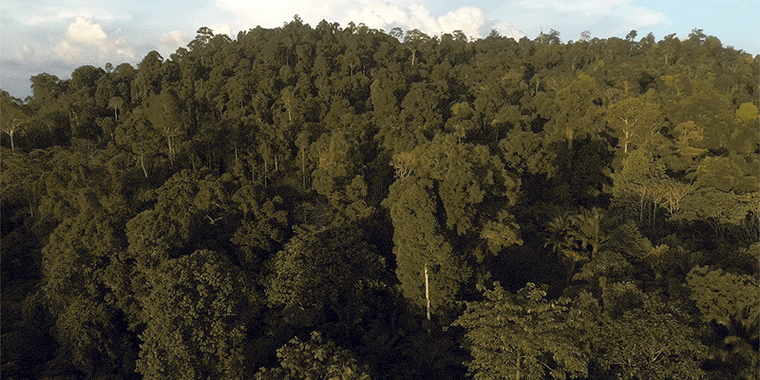
‘Large-scale deforestation’
Viscose, the fiber derived from the cellulose in wood, is a key component in everyday products such as baby wipes and face masks. When it is turned into a fabric, it’s referred to as viscose rayon.
Viscose rayon was first created more than 100 years ago. Cheaper and more durable than silk, the plant-based fabric is marketed in fashion circles as being sustainable and biodegradable. It has surged in popularity in recent years, growing into a multi-billion industry.
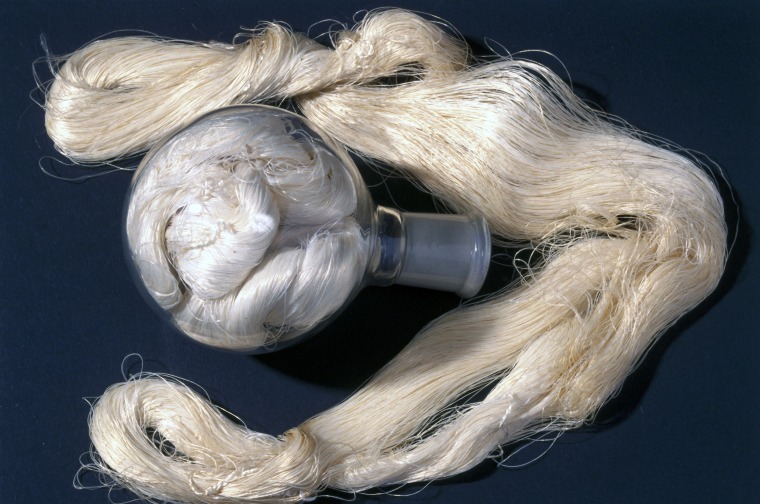
But some of the major companies in the viscose supply chain have drawn criticism for contributing to the destruction of rainforest in southeast Asia.
Asia Pacific Resources International Holding (known as APRIL Group), the second largest pulp and paper company in Indonesia, has long faced accusations of engaging in deforestation. It sources wood from several suppliers, including Adindo, which controls land on the Indonesian island of Kalimantan (also known as Borneo).
In June 2015, APRIL pledged to stop harvesting natural forest. The announcement, which came on the heels of similar pledges from some of its competitors, was praised by environmental groups.
The company has made significant progress in its efforts to limit deforestation. But some of APRIL’s suppliers, including Adindo, have been accused of clearing out intact rainforest since the company made its commitment.
In October 2020, a coalition of environmental groups released a report about deforestation on Adindo’s land based on satellite imagery and land-cover classification maps produced by the Indonesian government.
The report alleged that nearly 7,300 hectares [28 square miles] of natural forest was cleared within Adindo’s concession between June 2015 and August 31, 2020. Half of the deforestation occurred in areas that Adindo had designated as “high conservation value” forest, according to the report. On-the-ground reporting and drone footage were also used to make the determinations, according to Manurung, who was one of the lead authors.
APRIL denied the allegations at the time, saying no deforestation occurred in the areas cited in the report. APRIL said the land cleared on Adindo’s concession was located in designated plantation areas, none of which included “high conservation value” forest areas.
APRIL also previously denied the allegations that other suppliers cleared standing forest since June 2015.
Edward Boyda, a physicist who co-founded the environmental research group Earthrise, was asked by NBC News to analyze deforestation on roughly 4,200 square miles of land controlled by wood suppliers to APRIL on Kalimantan.
Using NASA and commercial satellite imagery, Boyda concluded that an estimated 30 square miles [7,700 hectares] of intact forest had been cleared on that land since late 2015. He described the 30 square miles as a conservative estimate.
Boyda says the imagery tells a story that begins with a contiguous green canopy and transforms into a growing patch of brown — what he calls “burn scars” from trees that have been felled and cleared. He says the time-lapse images show uniform rows of plantation trees cropping up.
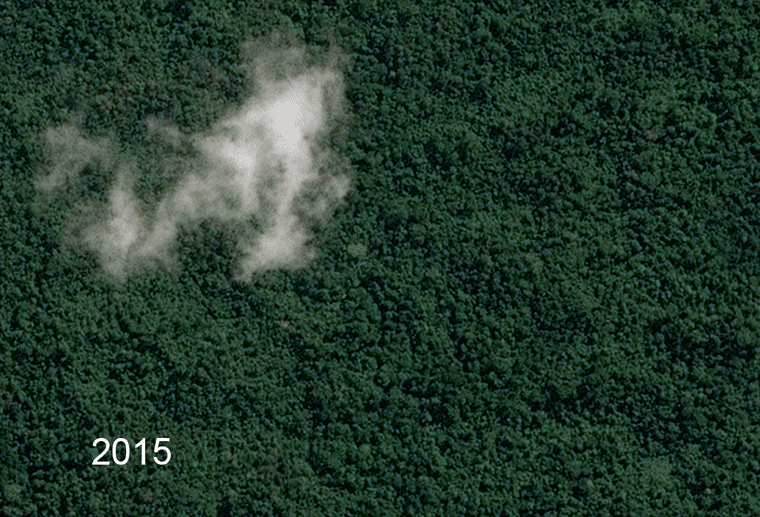
“You’ve gone from one of the most biodiverse places in the world to what’s essentially like a biological desert,” Boyda said in an interview from Norway, describing the change from rainforest to tree plantation.
APRIL Group disputed that its suppliers cut down sections of intact rainforest.
In a statement, the company said its analysis showed that the vast majority of the lost tree cover cited by Boyda represents the harvesting of trees on existing plantations.
“These are clearly not activities involving the deforestation of intact forest but are, in fact, linked to the normal legal plantation harvesting and replanting, and small scale community agriculture,” the company said.
APRIL Group noted that the amount of alleged deforestation on non-plantation land, 1,400 hectares [5 square miles], represents less than 0.1 percent of all of the land controlled by its suppliers on Kalimantan.
APRIL added that the tree cover loss detected on the 1,400 hectares consists of a mix of areas that have been “encroached or damaged by third parties” and is in some cases a result of errors in the “remote sensing algorithm” due to local conditions such as cloud and haze.
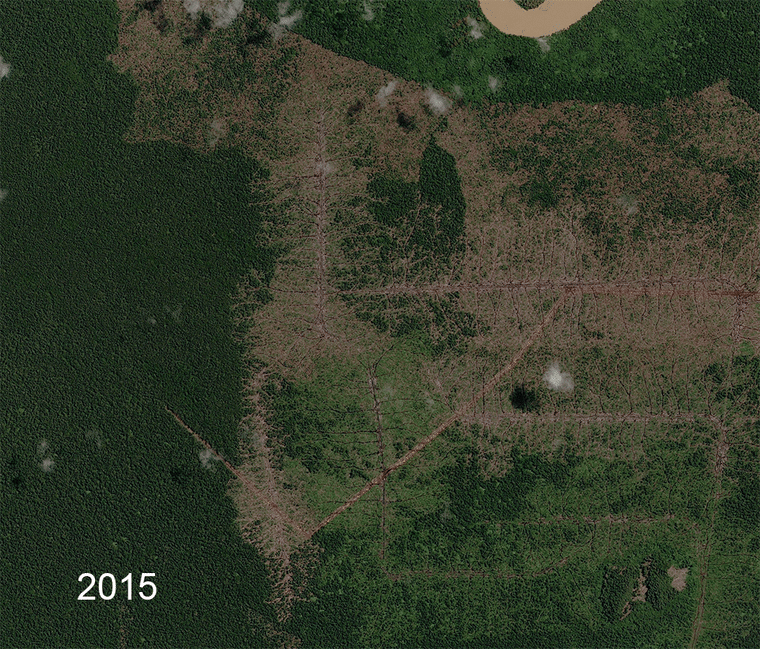
“Our company takes any allegation of illegal land cover change very seriously and investigates all cases that we identify or are brought to our attention,” APRIL Group said. “If an illegal activity is confirmed, we ensure that this is rapidly halted and reported to the appropriate authorities.”
The company also said it has met 81 percent of its commitment to conserve or protect one hectare of natural forest for every hectare of its plantation. “For us, production and conservation are mutually dependent where one enables the other,” APRIL Group said.
Last November, APRIL sent a letter to the Forest Stewardship Council, the world’s top industry certification program, acknowledging the “potential environmental and social harms” of its past operations dating back to 1993.
APRIL has been prohibited from using the council’s trademark to market its paper and pulp products since 2013 when it withdrew from certification. The company said it was withdrawing over concerns about FSC policy after three environmental groups filed a complaint accusing APRIL of “engaging in large-scale deforestation” in Indonesia.
The company has been seeking to be reinstated for several years. The process is ongoing, according to the Forest Stewardship Council, or FSC.
APRIL is managed by Royal Golden Eagle, a Singapore-based conglomerate that manages paper, palm oil and viscose businesses.
APRIL ships the wood from Kalimantan for processing on the nearby island of Sumatra, then to a facility in China operated by another company managed by Royal Golden Eagle, Sateri, where it is made into viscose. The resulting material resembles puffy cotton.
Sateri sends viscose to factories around the world that have supplied clothes to a host of major brands, including Adidas, Abercrombie & Fitch and H&M, according to an NBC News review of corporate disclosures. Sateri also sends viscose to U.S. facilities that produce baby, face and disinfecting wipes.
H&M and Adidas are among several major retailers that have come under pressure from NGO groups like Changing Markets for their use of viscose linked to forest destruction.
H&M said its manufacturing suppliers used to source material from Sateri, but the brand doesn’t “currently have any indirect business relationship with Sateri.”
Representatives for Adidas declined to comment. Abercrombie & Fitch did not respond to a request for comment.
Adidas and H&M were among 12 brands that joined a consortium last year dedicated to selling clothing made from recycled textile waste. The group, dubbed the “New Cotton Project,” is funded by the European Union.
In a statement, Sateri said it takes steps to ensure that its wood suppliers engage in “no deforestation or exploitation.”
“Regarding our dissolving pulp supplier APRIL, we reject suggestions that they have in any way ‘walked back’ on any of their sustainability commitments, including their steadfast commitment to no deforestation,” the statement said.
Royal Golden Eagle said it has “full confidence in the sustainability policies and commitments pursued by APRIL Group and Sateri.”
After this story was published, APRIL Group posted a response on its website.
“Regarding concerns expressed in NBC’s story that increased global demand for pulp, paper and viscose will lead to greater deforestation, that is simply not the case with APRIL or its suppliers," it read in part.
"APRIL has clearly stated that it has no intention of expanding its forest concessions and that future demand for fiber supply will be met from its existing supply chain, including from intensification and productivity gains from existing plantations."
Not all viscose is derived from tree plantations in and around tropical rainforests. There are also pulpwood plantations for viscose away from rainforests in places like South Africa and the Czech Republic.
Some companies have stopped using viscose altogether.
Dana Davis, the vice president of sustainability for the designer Mara Hoffman, said the company took a hard look at the source of its fabrics in 2015. Hoffman decided to move away from sourcing viscose rayon and use a different material instead, lyocell. Although it comes from trees, more than 99 percent of the solvent can be reused, and Davis said the company has a clearer picture of where the wood comes from.
“The last thing we want to be doing is sourcing from endangered forests,” Davis said.
‘We cannot fight back’
Jonni Spedika hardly knows anything about viscose rayon but he talks in great detail about how the destruction of the rainforest has changed his life. And he doesn’t mince his words.
Spedika lives in the village of Tetaban, one of the main communities of the Indigenous Dayak people, with his wife and 5-year-old daughter.
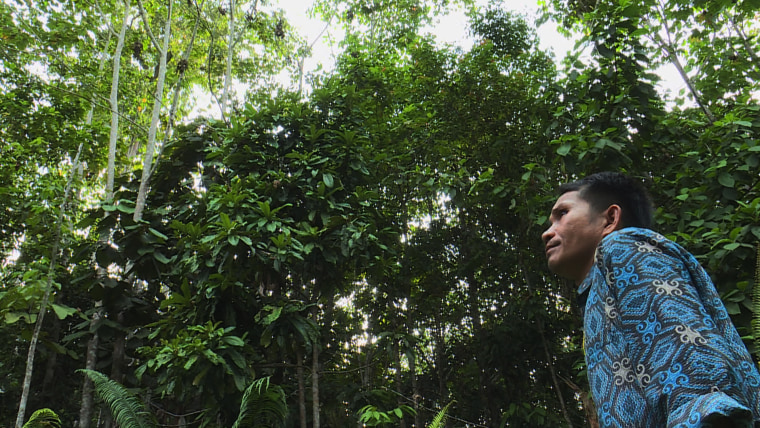
There was a time when he could venture 500 meters into the forest outside his home and hunt wild pigs and other animals with relative ease. But nowadays, Spedika said he can walk 5 kilometers [3 miles] into the forest and not encounter a single animal.
“It’s become very difficult for us to find any animals to hunt,” said Spedika, who runs a small chicken and vegetable farm to help feed his family.
Adindo, the wood supplier, controls an area around Spedika’s village that spans 190,000 hectares [700 square miles] of what used to be pristine rainforest.
Hendrik Siregar, a researcher with the Auriga environmental watchdog group, said people who buy clothing in the U.S. should be mindful of the impacts in places like Indonesia.
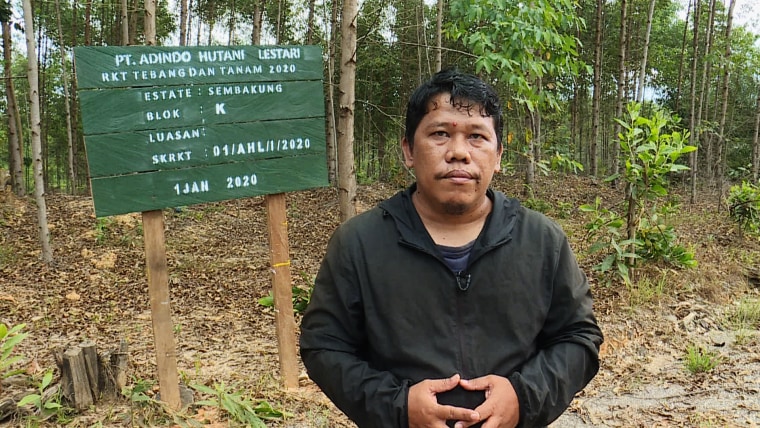
“Perhaps this will cause a debate about this material that is said to be environmentally-friendly,” Siregar said. “What’s clear is that we don’t see it as being environmentally-friendly because it continues to increase the amount of wood being chopped down.”
Adindo did not respond to requests for comment.
Spedika said the climate around his village has changed along with the surrounding forest — it’s drier and hotter due to the reduced tree cover, and both floods and fires occur more often.
“We cannot fight back,” Spedika said. “Because they have the permits, this area became theirs. We can only resign to our fate.”


